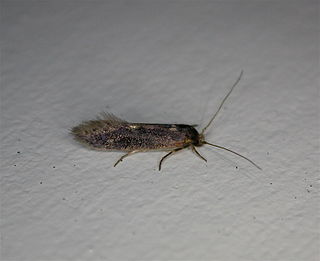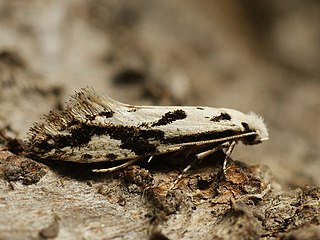
Tineidae is a family of moths in the order Lepidoptera described by Pierre André Latreille in 1810. Collectively, they are known as fungus moths or tineid moths. The family contains considerably more than 3,000 species in more than 300 genera. Most of the tineid moths are small or medium-sized, with wings held roofwise over the body when at rest. They are particularly common in the Palaearctic, but many occur elsewhere, and some are found very widely as introduced species.
Tineoidea is the ditrysian superfamily of moths that includes clothes moths, bagworms and relatives. There are six families usually included within it, Eriocottidae, Arrhenophanidae, Lypusidae, Acrolophidae, Tineidae and Psychidae, whose relationships are currently uncertain.

Monopis imella is a moth of the family Tineidae found in Europe.
Kangerosithyris is a genus of moths belonging to the family Tineidae.
Lysitona is a genus of moths belonging to the family Tineidae. As of 2018, it contains only one species, Lysitona euryacta, which is found in Mozambique.
Miarotagmata is a genus of moths belonging to the family Tineidae. It contains only one species, Miarotagmata penetrata, which is found in South Africa and Zimbabwe.

Pyloetis is a moth genus, belonging to the family Tineidae. It consists of only one species, Pyloetis mimosae, which is found in Asia, including Japan and Taiwan.

Opogona omoscopa is a moth of the family Tineidae.
Vactor Tousey Chambers was an American entomologist who specialized in Lepidoptera, specifically, Tineina. He, along with James Brackenridge Clemens, was a pioneer in the study of these insects. He described many new species.
Archinemapogon yildizae is a moth of the family Tineidae. It was described by Ahmet Ömer Koçak in 1981. It is found in most of Europe, except Ireland, the Benelux, the Iberian Peninsula and most of the Balkan Peninsula. The habitat consists of birch woodlands.

Haplotinea insectella, the drab clothes moth or fungus grain moth, is a moth of the family Tineidae. It was described by Johan Christian Fabricius in 1794. It is found in all of Europe, except Ireland, the Iberian Peninsula and the western and southern part of the Balkan Peninsula. It is also found in North America. The species is often found in warehouses, granaries, mills and farm buildings.
Infurcitinea ignicomella is a moth of the family Tineidae. It was described by Heydenreich in 1851. It is found in large parts of Europe, except Ireland, Great Britain, Belgium, the Iberian Peninsula, Ukraine and most of the Balkan Peninsula.

Infurcitinea argentimaculella, the silver-barred clothes moth, is a moth of the family Tineidae. It was described by Stainton in 1849. It is found in most of Europe, except Ireland, Portugal, Latvia, Lithuania and the Balkan Peninsula.

Karsholtia marianii is a moth of the family Tineidae. It was described by Rebel in 1936. It is found in Norway, Sweden, Denmark, Germany, Austria, France and on Sicily.

Nemapogon picarella, the pied clothes moth, is a moth of the family Tineidae. It was described by Carl Alexander Clerck in 1759. It is found in most of Europe, except Ireland, the Benelux, the Iberian Peninsula and the Balkan Peninsula.

Monopis spilotella is a moth of the family Tineidae. It was described by Tengström in 1848. It is found in Scandinavia, Denmark, the Baltic region and Ukraine and Russia. It is also found in North America.

Triaxomera fulvimitrella, the four-spotted clothes moth, is a moth of the family Tineidae. It is found in most of Europe, except Ireland, the Iberian Peninsula, Italy, Slovenia and most of the Balkan Peninsula. The habitat consists of woodlands.

Nemapogon clematella, the barred white clothes moth, is a moth of the family Tineidae. It is found in most of Europe and in North America, where it has been recorded from Maryland and North Carolina. The habitat consists of woodlands.
Triaxomasia caprimulgella is a moth of the family Tineidae. It found in most of Europe, except Ireland, Luxembourg, Spain, Finland, the Baltic region and the central part of the Balkan Peninsula.

Nemapogoninae is a fungus moth subfamily of the family Tineidae. It was described by Hinton in 1955.












